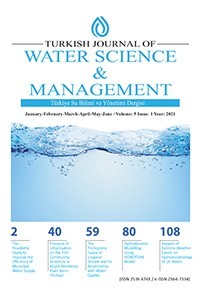Investigating the Effect of Climate Change on Stormwater Networks: Capital Ankara Case
Investigating the Effect of Climate Change on Stormwater Networks: Capital Ankara Case
Climate Change Stormwater, Nonstationary, Extreme Rainfall,
___
- Bahadur, A., Tanner, T., and Pichon. F. (2016). Enhancing Urban Climate Change Resilience: Seven Entry Points for Action. Manila. Asian Development Bank. ©ADB.
- Batuman, B. (2013). City profile: Ankara. Cities, 31. 578–590. 10.1016/j.cities.2012.05.016
- Burke, C. B., & Burke, T. T. (2015). Stormwater Drainage Manual 2015. Indiana Local Technical Assistance Program (LTAP) Publications. 100.
- Efe, M. (2006). Review of modelling softwares used in design and operation of sewerage and storm water collection systems, (Master's Thesis), Graduate School of Natural and Applied Sciences, Istanbul Technical University.
- Elshorbagy, A., Lindenas, K., & Azinfar, H. (2018). Risk-based quantification of the impact of climate change on storm water infrastructure. Water Science, 32(1), 102-114.
- Hailegeorgis, T. T., & Alfredsen, K. T. (2017). Analyses of extreme precipitation and runoff events including uncertainties and reliability in design and management of urban water infrastructure. Journal of Hydrology. 544. 290-305
- Kundzewicz, Z. W. (2003). Extreme precipitation and floods in the changing world, Water Resources Systems—Hydrological Risk, Management and Development. Proceedinss of symposium HS02b held during IUGG2003 al Sapporo.
- Larsen, A. N., Gregersen, I. B., Christensen, O. B., Linde, J. J., & Mikkelsen, P. S. (2008). Future development in extreme one-hour precipitation over Europe due to climate change. In 11ICUD, 11the International Conference on Urban Drainage, Edinburgh, Scotland, 31st August-5th September 2008 (Vol. CD-ROM). Sheffield, UK: University of Sheffield.
- NYC, (2012). Guidelines for the Design and Construction of Stormwater Management Systems. Developed by the New York City Department of Environmental Protection in consultation with the New York City Department of Buildings.
- Osman, Y. (2014). Monitoring the future behaviour of urban drainage system under climate change: a case study from north-western England. Open Engineering, 5(1). doi:10.1515/eng-2015-0003
- Oruc, S., Yucel, I., Yilmaz, A. (2019) Investigation of The Effect of Climate Change on Extreme Precipitation: Capital Ankara Case, Manuscript submitted for publication.
- Özkil, A. (2015). Searching for the Crumbles of Nature in the Metropolitan Ankara. Unpublished manuscript. Middle East Technical University, Ankara
- Rosenberg, E. A., Keys, P. W., Booth, D. B. (2010). Precipitation extremes and the impacts of climate change on stormwater infrastructure in Washington State. Climatic Change. 102, 319. https://doi.org/10.1007/s10584-010-9847-0
- Shuster, W. D., Bonta, J., Thurston, H., Warnemuende, E., &. Smith, D. R. (2005). Impacts of impervious surfaces on watershed hydrology: A review, Urban Water J., 2(4), 263–275.
- Simonovic, S. P., Schardong, A. Sandink, D., & Srivastav, R. (2016). A Web-based tool for the development of intensity duration frequency curves under changing climate. Environmental Modelling & Software Journal, 81:136-153.
- Sun, Z., Guo, H., Li, X., Huang, Q., & Zhang, D. (2011). Effect of LULC change on surface runoff in urbanization area. Proceedings of the ASPRS 2011 Annual Conference, Milwaukee, Wisconsin, May 1–5.
- TDT, (2016). Hydraulic Design Manual. Texas Department of Transportation.
- Thakali, R., Kalra, A., & Ahmad, S. (2016). Understanding the effects of climate change on urban stormwater infrastructures in the las vegas valley. Hydrology, 3, 34.
- Trenberth, K. E. (1998). Atmospheric moisture residence times and cycling: Implications for rainfall rates with climate change. Climatic Change, 39, 667-694.
- United Nations, (2018). World urbanization prospects: The 2018 revision. New York.
- Yilmaz, E., (2013). Ankara Şehrinde Isi Adasi Oluşumu, PhD. Thesis, Ankara University, Ankara
- Zhou, Q. (2014). A review of sustainable urban drainage systems considering the climate change and urbanization impacts. Water, 6(4), 976-992
- ISSN: 2536-474X
- Başlangıç: 2017
- Yayıncı: Tarım ve Orman Bakanlığı Su Yönetimi Genel Müdürlüğü
Effects of Irrigation and Field Management Practices within Water Resources Systems
Mehmet Can GÜÇLÜ, Abebe DEMİSSİE CHUKALLA, Pieter VAN OEL
Assessment and Comparison of Commonly Used Eutrophication Indexes
Duygu ÜLKER, İrşad BAYIRHAN, Selmin BURAK
Parameter Selection for Chemical Monitoring of Sediment in Lake Beysehir
Bahar Ayşe AYDIN İŞERİ, Ozan SOYTÜRK
Composition and Distribution of Benthic Diatoms in Different Habitats of Burdur River Basin
Ayça OĞUZ ÇAM, Muhammet Aydın KALELİ, Reyhan AKÇAALAN ALBAY, Latife KÖKER DEMO, Zeynep DORAK, Özcan GAYGUSUZ, Fatih AYDIN, Tolga ÇETİN, Yakup KARAASLAN, Meriç ALBAY
Investigating the Effect of Climate Change on Stormwater Networks: Capital Ankara Case
